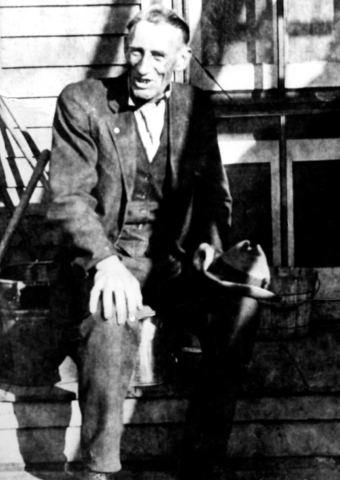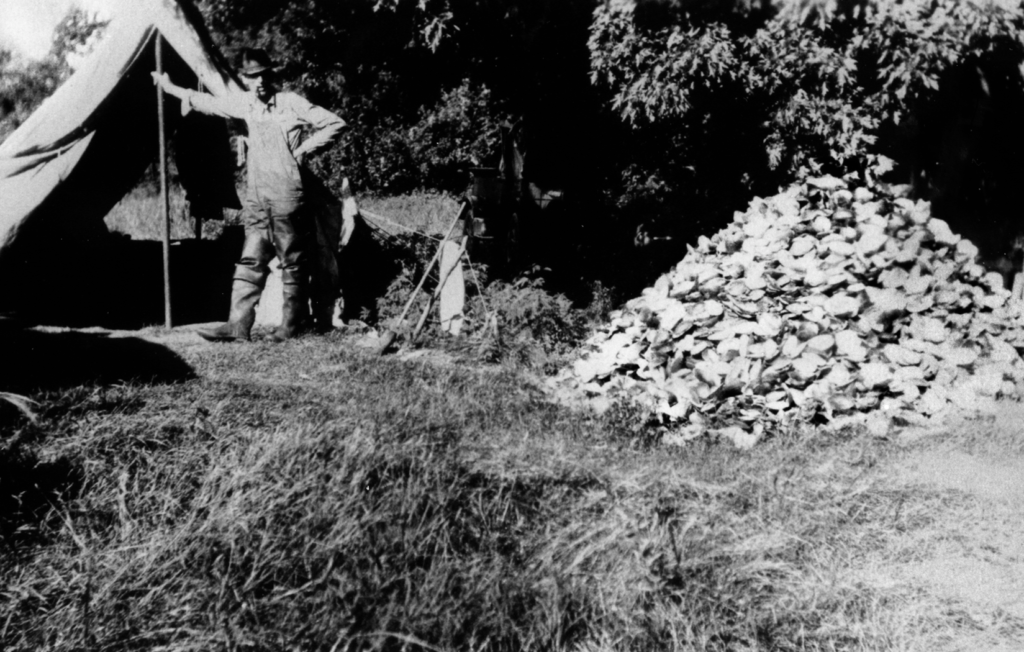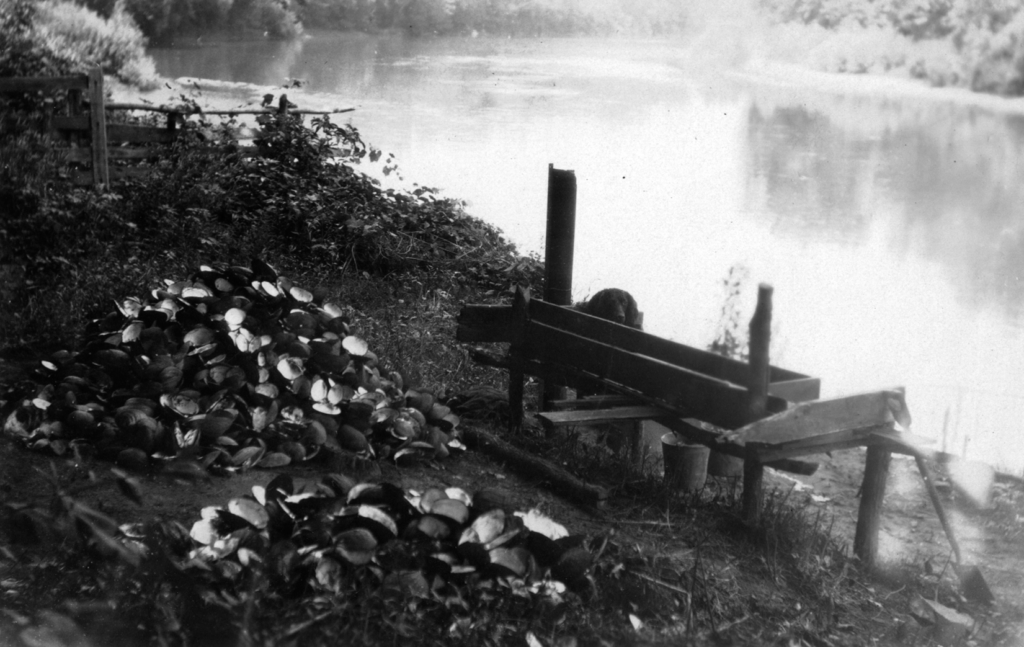
SRHS
Steamboat Rock Historical Society
TRAILS BECOME ROADS
“SPIKE” KLUGER & CLAMMING
All communities from time to time have within them what the general population terms “characters”. Steamboat Rock developed many unique characters. Among these one of the more interesting was Gust. C. Kluger.
August Christian Kluger was born on August 22, 1871 in Ackley, Iowa. He was the son of Albert and Catherine Kluger. Gust as he was sometimes known had three brothers and one sister; Will, Otto, Herman, and Bertha. For reason not known, Gust and his brothers and sister were all either abandoned or their parents died leaving them on their own at a young age.
Gust was in the reform school in Eldora in 1883 at the age of twelve, not for wrong doing but because he had nowhere else to go. He remained there for at least two years. At this same time his sister Bertha was at the county poor farm near Eldora. It is believed that Gust was also there for a short time. While at the training school Gust wrote two letters to his sister; one asking if she knew where the others were; the other asking if she could please send him a small Christmas gift.
His brother Will was adopted, and took the name Eldrige. Bertha was eventually adopted by a family named Shattuck, and eventually married a Shattuck.

Gust (Spike) Kluger
Herman worked on a farm near Clarion for a time for no pay. He eventually walked away and herded cattle on the open prairie in northwest Iowa. He was 14 years old a the time.
Gust, Herman and Otto eventually ended up in Steamboat Rock, but only Otto lived out his life there. Herman and his family left Steamboat Rock in 1910 and settled in Swea City, Iowa.
Gust was a house painter by vocation, and an artist by avocation. He was a bachelor whose hair was tinged with gray. He was said to be shy of manner and so tall that he appears slim, which probably accounts for the nickname “Spike.” Spike lived in an apartment above Mel Baker’s Drugstore.
Mildred Dunn Lepper used a corner of his studio as a playhouse and recalled, “Since there was no room at our living quarters for me to keep my few treasures, I was at a loss for a place to play As far back as I can remember, I liked to play by myself, and to conjure up imaginary playmates. This problem was solved when our good neighbor, “Spike” offered me a corner in his “studio”.
“Spike was not his real name, but everyone called him that. His real name was Gus Kluger. He was a man who liked to paint. He not only painted houses, but also liked to paint pictures on canvas. He had many of these hanging on his walls. One was so large, it covered much of a wall. He lived upstairs above Mel Baker’s drug store. You climbed an outside stairway to get there. He was gone much of the summer painting houses or camping along the river where he fished for clams. He sometimes found a pretty pearl in an occasional clam and could sell these for considerable money, if they were perfect The imperfect ones were called “slugs”, and these could be attached to a chain for a lady to wear around her neck. This was called a lavaliere and was fashionable at that time. Spike was a kind man and respected in the community. He had so much room in his studio, he did not miss the space in one corner which he allowed me for a playhouse. My dolls were never disturbed and always were right where I had left them. I loved to study the Sears Roebuck catalog and copy the styles for clothing for Toots. That beloved and battered relic was just the right size to sew for, because she was only about six inches tall, so even a small scrap of cloth was large enough for a dress for Toots. Her body was cloth and she was stuffed with cotton. A new design could be draped on, attached with pins, and removed at the whim of the young designer. The new doll, Irma Cleone, which I had received for Christmas in Oregon, could not take such treatment, for she was a kid bodied, elegant lady, stuffed with sawdust, which soon would sift through the pin holes. That would never do. That was why Toots had the more extensive wardrobe of the two. The doll cart Uncle Johnny had made me was packed into our trunk when we came back from Oregon, and I had various pieces of furniture I had concocted from spools, cardboard and my imagination. Cigar boxes from the restaurant made great storage for small possessions. Many a happy hour was passed up at Spike’s.”
Spike was interviewed in 1918 by a reporter of the Eldora Herald. Part of that interview follows:

Spike and a pile of clam shells he had collected for the button factory in Muscatine, Iowa.
“As the Herald man climbed the stairs to Mr. Kluger’s bachelor quarters he found on a platform which had been built out over an adjoining roof an unusually fine collection of house plants, which led him to wonder if he had

Spike Kluger’s rack used for cleaning the clams that he collected along the Iowa River and other rivers around Iowa.
made a mistake and would find a lady living there. When he knocked, however, it was the tall man who came to the door. While the room showed the absence of a woman’s touch, no woman would have kept it cleaner. Glancing through into the front room he caught sight of an artist’s easel on which stool a partly finished marine view in oil. Near by hung a well kept artist’s palette.”
“As the newspaper man stepped in to examine and admire Mr. Kluger explained that he had merely taken the work up without instruction and that his work was full of imperfections. The writer however, has seen some oil paintings and does not hesitate to say that among them there were many who’s products are much more pretentious, which do not equal these in quality.”
“His best known work is probably on the curtain of the theater, which Mr. Barlow induced him to undertake. It is the local power house and dam from a point east of the bridge. It is excellent work but no better than his smaller pieces which are every one worth examination.”
Today one of Gust Klugers more famous paintings hangs in the local library. It is a very nice rendering of the “Old Mill.”
Gust was said to be shy of manner and so tall that he appears slim, which probably accounts for his nickname “Spike.”
Beyond his occupation as a house painter, Spike could be found much of the time camped out on the river, fishing, trapping and collecting clam shells and buying them from others for a Muscatine Button Factory. Over the years Spike collected thousands of clams from the Iowa and other rivers.
It is unclear if Spike moved from Steamboat Rock, or if he was on one of his clamming expeditions when he fell ill. Many of his clamming trips did take him beyond the Iowa River. He was known to camp on the Des Moines, near Humbolt, and the Wapsipinicon, near Troy Mills.
In late 1941 prior to one of Spike’s nephews entering the Air Force, he accompanied his parents Mr. and Mrs. Herman Kluger to a retirement home near Cedar Rapids. They found Spike in a terrible place that was filthy and where he was getting little or no care. Spike was unable to speak. He was moved to a nursing home in Marion.
Gust “Spike” Kluger passed away on February 20, 1942 at Marion, Iowa at the Reamer Retirement Home. He had been there for two months and twenty-two days. Gust is buried at Troy Mills, Iowa.
© 2020 Steamboat Rock Historical Society | All Rights Reserved
Powered by Hawth Productions, LLC